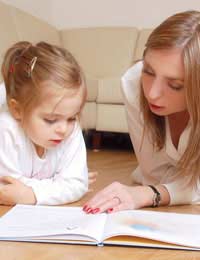Reading a Picture Book

Reading a picture book may seem like a strange idea, given that picture books tend to have very few, if any, words. Yet sitting down with your child and opening a picture book can be a great opportunity for your child to develop language and literacy skills. The next time you open up a picture book together remember to ask your child about the story, build upon his or her answers, repeat key words and phrases and ask about the words you both use so together you can learn and enjoy together.
Ask About the Story
The next time you crack open a picture book with your child, read the title aloud and begin your questioning. Ask open ended questions that will encourage him or her to give longer answers, and don’t stop your child when (s)he is mid-flow. Consider asking:- What (s)he thinks will happen given the title of the book?
- Who or what the characters are, including descriptions?
- What (s)he thinks the characters want to do or are doing?
- What the names of particular objects in the book are?
- What the number or colour of the objects shown are?
- What is happening on the page?
- What does (s)he think the characters are feeling on that page?
Build Upon the Answers
When your child answers your questions, build upon the answers (s)he gives. Younger children in particular may answer just a few words like “baby crying” so be sure to repeat the correct answer back to them building upon their words to create a full sentence like “Yes, the baby is crying.” Then ask more questions to help build a short answer into a longer story, such as “Why do you think the baby is crying?” If your child answers something that is not indicated in the picture book, ask something like “Is that what you see on the page?” if you decide to redirect him or her to the story as shown.Repeat Words and Phrases
As your child talks about the picture book, correct key words or phrases that (s)he uses several times. Correct both for pronunciation of the words as well having your child say full, grammatically correct sentences as their answers. Ask your child to repeat exactly what you have said when you’ve corrected pronunciation and grammar, and even more than once. As your child becomes more comfortable with vocabulary and grammar, (s)he will start to use them more naturally in his or her own speech.Ask About the Words
As well as worrying about constructing language through the pronunciation of words and the grammatical rules of keeping them organised, ask your child about the meaning of the vocabulary (s)he uses. You could do this by saying:- “The dog is wearing blue. What else is blue on this page?”
- “The teacup is smiling. What does that mean?”
- “The duckling is the littlest. How do you know that?”
- “There are 12 coins on the page. Can you count them each for me again?”
- “She’s having a snack. What is she eating?”
Related Articles in the 'At Home Activities' Category...
- Using Board Games to Encourage Speech
- Using the Internet in Speech Practice
- Speech Practice and Household Chores
- Including Siblings in Speech Practice
- Questionnaire: Do You Encourage Speech at Home?
- Encouraging Speech Through Charades
- Moving Beyond Baby Talk
- Nursery Songs and Speech
- Speech and Shopping Lists


Re: The Lidcombe Program
My 3 year old has started to stammer about 5 weeks ago and has progressed very fast and now it affect every word she pronounces and I am…
Re: Child Abuse and Speech Disorders
I stopped talking to my dad in my normal voice when I was in grade 1 after he hit me because I couldn’t understand my…
Re: New Earpiece to Help With Stammering
I am interested in being assessed for the use of the SpeechEasy hearing device and would be grateful if someone could…
Re: The Lidcombe Program
I don’t know what else to do ..
Re: New Earpiece to Help With Stammering
I have a Stammer and have always struggled with my speech and I think this would really help me and so many others.
Re: The Lidcombe Program
Sir I only stutter when speaking to others. Not when, I speak to myself can you tell me what's the problem.
Re: The Lidcombe Program
I am 23 years I am supering from stammer please how can I get vaccine for ti
Re: Expressive Language Disorder
I have a lot to ask . Please reach out. Thank you
Re: The Lidcombe Program
My age is 32...when IAM speaking difficulty to say word...IAM disappointed in my life only reason is stammring..plz help me...
Re: The Lidcombe Program
Is there any advice for a child who has been really forward with his speech since 2 he has stung sentences together so clearly. He has now…